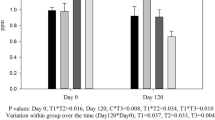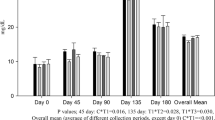Abstract
The aim of this study was to determine the levels of trace minerals Zn, Cu, and Se, the effect of dermatophytosis on the level of thiobarbituric acid reactive substances (TBARS) as an indicator of lipid peroxidation, the status of enzymatic and nonenzymatic antioxidants, and the relationship between the mentioned trace minerals and antioxidant defense system in calves with dermatophytosis. A total of 21 Holstein calves with clinically established diagnosis of dermatophytosis and an equal number of healthy ones were included in this study. Results showed that 81% of mycotic isolates were Trichophyton verrucosum, while 19% were Trichophyton mentagrophytes. The level of Zn, Cu, Se, and glutathione (GSH) and the activity of the antioxidant enzymes, glutathione peroxidase (GSH-Px), and superoxide dismutase (SOD) were significantly (P ≤ 0.05) lower. The plasma level of TBARS was significantly (P ≤ 0.05) higher in dermatophytic calves compared to healthy controls. SOD activity was fairly correlated with serum Cu and positively correlated with serum Zn in healthy control (r = 0.68, P ≤ 0.05; r = 0.58, P ≤ 0.05) and in calves affected with dermatophytosis (r = 0.73, P ≤ 0.05; r = 0.55, P ≤ 0.05), respectively. GSH-Px activity was highly correlated with whole blood selenium (r = 0.78, P ≤ 0.05) in healthy control and dermatophytic subjects (r = 0.76, P ≤ 0.05). Our results demonstrated that in dermatophytosis, the alteration in the antioxidant enzyme activities might be secondary to changes in their cofactor concentrations.
Similar content being viewed by others
References
Stannared AA (1990) Mycotic diseases. In: Smith BP (ed) Large animal internal medicine. Mosby, St. Louis, pp 1272–1273
Scott DW (1988) Large animal dermatology. Saunders, Philadelphia, pp 172–182
Al-Qudah KM, Wass WM, Niyo Y, Kluge J (1994) Selenium responsive dermatosis in cattle, a report on two cases. Iowa State Veterinarian 56(2):78–80
Al-Ani FK, Younes FA, Al-Rawashdeh OF (2002) Ringworm infection in cattle and horses in Jordan. Acta Vet Brno 71:55–60
Nisbet C, Yarim GF, Ciftci G, Arslan HH, Ciftci A (2006) Effect of trichophytosis on serum zinc levels. Biol Trace Elem Res 113:273–279
Van den Broek AH, Staford WL (1988) Diagnostic value of zinc concentration in serum, leucocytes and hair of dogs with zinc-responsive dermatosis. Res Vet Sci 44:414
Krametter-Froetscher R, Hauser S, Baumgartner W (2005) Zinc responsive dermatosis in goats suggestive of hereditary malabsorption: two field cases. Vet Dermatol 16:269–275
Mullowney PC (1982) Dermatologic diseases of cattle. Part II. Infectious diseases. Compendium Contin Educ 4(1):S3–S12
Banerjee BN, Banerjee PK, Chatterjee SS (1973) Studies on histochemical changes of epidermis under griseofulvin and vitamin A therapy in dermatophytosis. Indian J Dermatol 19(1):1–6
El-Bayoumy K (2000) The protective role of Se on genetic damage and on cancer. Mutat Res 475(1–2):123–139
Halliwell B (1991) Reactive oxygen species in living system: source, biochemistry, and role in human disease. Am J Med 91(Suppl 3C):14S–22S
Chow CK (1988) Interrelationship of cellular antioxidant defense systems. In: Chow CK (ed) Cellular antioxidant defense systems. CRC, Boca Raton, pp 217–238
Cheesbrough M (1992) Medical laboratory manual for tropical countries. Volume 2. Tropical Health Technology, Butterworth-Heinemann, Oxford, pp 371–378
Halley LD, Standard PG (1973) Laboratory methods in medical mycology, 3rd edn. US Department of Health, Education and Welfare Center of Disease Control, Atlanta, pp 41–57
Paglia DE, Velentine WN (1967) Studies on the quantitative and qualitative characterization of erythrocyte glutathione peroxidase. J Lab Clin Med 70:158–169
Sun Y, Oberley LW, Li Y (1988) A simple method for clinical assay of superoxide dismutase. Clin Chem 34:497–500
Buetler E, Duron O, Kelly B (1963) Improved method for blood glutathione. J Lab Clin Med 61:882–888
Yagi K (1984) Assay for blood plasma and serum. Method in Enzymology 105:328–331
Braun U, Forrer R, Furer W, Lutz H (1991) Selenium and vitamin E in blood sera of cows from farms with increased incidence of disease. Vet Rec 128:543–547
Ranjan R, Swarup D, Naresh R, Patra RC (2005) Enhanced erythrocytic lipid peroxides and reduced plasma ascorbic acid, and alteration in blood trace elements level in dairy cows with mastitis. Vet Res Commun 29(1):27–34
Kojouri GA, Ebrahimi A, Zuheri M (2009) Zinc and selenium status in cows with dermatophytosis. Comp Clin Pathol 18:283–286
Stockdale PM (1953) Nutritional requirements of the dermatophytes. Biol Rev 28(1):84–104
Halliwell B (1999) Antioxidant defense mechanisms: from the beginning to the end of beginning. Free Radic Res 31:261–272
Karapehlivan M, Uzlu E, Kaya N, Kankavi O (2007) Investigation of some biochemical parameters and the antioxidant system in calves with dermatophytosis. Turk J Vet Anim Sci 31(1):1–5
Knowles SO, Grace ND, Wurms K, Lee J (1999) Significance of amount and form of dietary selenium on blood, milk, and casein selenium concentration in grazing cows. J Dairy Sci 82:429–437
Lee SH, Park BY, Lee SS, Choi NJ, Lee JH, Yeo JM, Ha JK, Maeng WJ, Kim WY (2006) Effect of spent composts of selenium-enriched mushrooms on carcass characteristics, plasma glutathione peroxidase activity, and selenium deposition in finishing Hanwoo steers. Asian-Aust J Anim Sci 19:984–991
Pasa S, Kiral F (2009) Serum zinc and vitamin A concentrations in calves with dermatophytosis. Kafkas Univ Vet FaK Derg 15(1):9–12
Author information
Authors and Affiliations
Corresponding author
Rights and permissions
About this article
Cite this article
Al-Qudah, K.M., Gharaibeh, A.A. & Al-Shyyab, M.M. Trace Minerals Status and Antioxidant Enzymes Activities in Calves with Dermatophytosis. Biol Trace Elem Res 136, 40–47 (2010). https://doi.org/10.1007/s12011-009-8525-4
Received:
Accepted:
Published:
Issue Date:
DOI: https://doi.org/10.1007/s12011-009-8525-4




